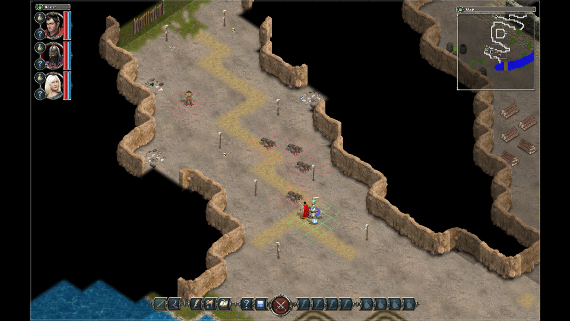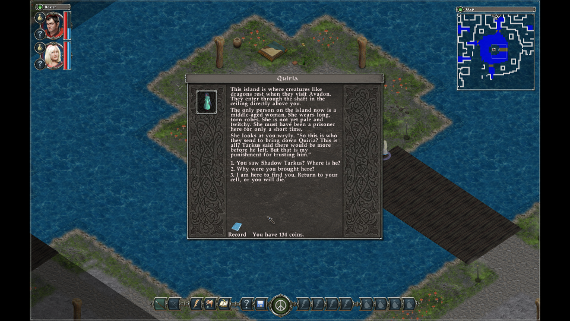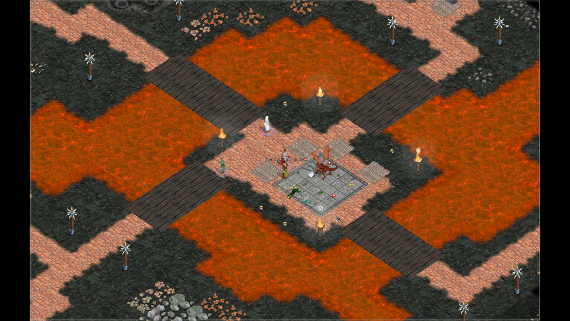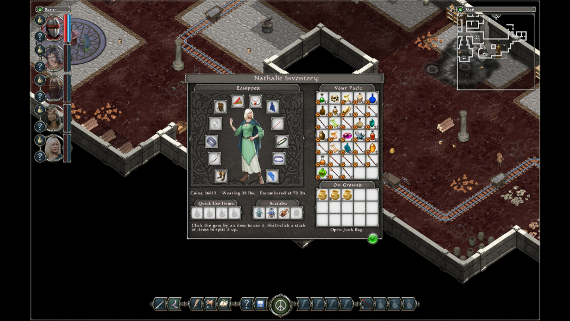
Jeff Vogel has been making indie RPGs since the mid-1990s but they always looked so cheaply produced that I never paid much attention to them. But when he brought his latest game to Steam and gave it decent graphics to boot, I thought that it was the right time to check out his work. After putting in more than 60 hours into the game, I’m happy to say that not only is it absolutely worth your money and time, but it’s one of the best RPGs I’ve ever played.
The Good Stuff
- It’s a tile-based fantasy RPG with 2D graphics made by mostly one person, so you need to come in with lowered expectations. The combat is turn-based and quite crunchy but the game’s main strength is its setting and writing. Text is used liberally, not only in dialogue but also in descriptions of scenes and places to supplement the graphics. This will turn off impatient players who hate reading but I’ve been a big fan of this approach since Darklands so this is a huge plus for me.
- You play as a Hand of Avadon, the Black Fortress that protects the five nations of the Pact. For decades now the Pact nations have enjoyed relative peace as the strength of Avadon keeps the various powers of the Farlands at bay. But the real value of Avadon lies not in quickly identifying and striking down threats to the Pact from without but in stiffling rebellion and quelling internal conflict within the Pact itself so that its unity is never seriously threatened.

- To ensure Avadon’s impartiality and its independence from day-to-day politics, the Keeper and Lord of Avadon is appointed for life. This is Redbeard, the current and strongest ever Keeper of Avadon and your master, who has ruled Avadon for more than fifty years with an iron fist, and yet remains young due to powerful magics. Under Redbeard’s leadership the enemies of the Pact quell in fear at the very mention of Avadon but the price is that Avadon dispenses its justice harshly and indiscriminately. Redbeard will not hesitate to raze an entire village as an example to those who would do harm to the servants of Avadon.
- The central dramatic tension is the harshness of Redbeard’s methods on the one hand and their effectiveness on the other. This, combined with the clear knowledge that there are plenty of enemies who will do harm to the Pact and all who live in it if Avadon should appear weak, and that if they won they would be no better than Redbeard makes for a moral quandary the likes of which I’ve rarely seen in any game. As an astute QT3 poster commented, you’re basically working for the CIA and it is every bit as corrupt and evil as anyone ever imagined. Yet at the same time, the enemies of the Pact are no better and often even worse. The CIA may be bad guys, but at least they’re bad guys who are on your team.
- This leads to some of the best writing in any RPG I’ve played, with characters that I care about and react to above and beyond the game’s mechanics. For example, Avadon takes a page from Bioware by including a loyalty quest from each of your companions but this is the first time in any RPG that the choices affected me enough that I chose to abandon one companion’s quest rather than complete it. This was because I thought he was an idiot who should have let bygones be bygones and let his personal quest for vengeance slide in favor of the greater good. I did this knowing fully well that this meant he would leave me at the final segment of the game and he was even the best equipped of my companions.

- The old-school combat is unashamedly hard. Are you tired of RPGs in which you accumulate a ton of consumables just in case you need them for the next fight and end up finishing the game without needing to drink a single healing potion? Well, in Avadon, particularly if you play at a harder difficulty setting, you’re pretty much obliged to use everything at your disposal to win. This includes choosing the right companions to bring, equipping them and levelling them appropriately and using up consumables. For the most part, if you pay attention to everything, all fights that are part of the main plot are winnable but still challenging. The optional fights however are another story completely. I couldn’t beat the second hardest encounter in the game at Hard difficulty no matter what I did and I’m not sure if anyone has ever beaten the hardest encounter at Torment difficulty since the game was released.
- For such a modestly produced game, Avadon includes an astonishing variety of quests, set-pieces and game elements. There is plenty of standard dungeon-crawling sure, but there are also stealth sequences in which it’s to your advantage to avoid enemies, an assault sequence in which you lead a good number of NPCs on a frontal assault of an enemy fortress, puzzles etc. It also has a rudimentary crafting mechanic, skill trees for each class, enough items and spells to play around with. It’s all very well-rounded and satisfying.
- One thing I particularly liked is how the game turns a disadvantage into an advantage. You don’t actually get to visit that many places in the game and obviously one reason for that is that making so many new maps would be expensive. So what happens is that you’re sent to one place to solve a problem and then later in the game, you’re told to go back there to solve another problem that has cropped up. Reusing art assets and NPCs is cheap, you see? But this ends up being very cool because small things about the place change on subsequent visits to reflect the consequences of your actions the last time you were there and you get to talk to the people about what you did. It makes the places feel real and prevents NPCs from feeling like quest dispensers. And you feel real emotion when you’re forced to kill someone you’ve previously developed a good working relationship with on previous quests because the two of you ended up on different sides.

The Not So Good Stuff
- There are niggling usability issues everywhere. For example, whenever you enter a zone from the world map, you always start at the same location. This is extremely annoying and makes for unnecessarily long travel times not to mention being illogical. If you enter a zone from the west, you should start in the west of the zone, not at the far end. The maps are also usually designed so that paths through them are very circuitous, to ensure that you spend more time on it. This is okay the first time but annoying on later visits when you know exactly where to go and you know that you’ve already cleared the map of enemies but just need to go somewhere to hand in a quest or buy something.
- Some of the map layouts don’t make much sense. So this undercover operative of Avadon sets up shop right next to a wretch fortress and they just ignore each other? Right. I like to call this World of Warcraft syndrome which compresses the world so that everything of note is within a short distance of everything else, but given that there are patches of emptiness on many maps, this wasn’t very necessary here.
- Class and item balance are a bit iffy. The Blademaster’s Challenge ability seems to do nothing for example while ranged weapons work so much better than melee that you’re handicapping yourself if you don’t make every member of your party into a ranged fighter. Sometimes stats don’t seem to be tied to abilities in a logical way. So even melee-based area of effect attacks work off of Dexterity instead of Strength? Remind me why I want Strength anyway since Dexterity is far and away the best stat as it boosts both ranged damage and makes it harder to enemies to hit you. Broad categories of weaponry seem pointless. Broadswords are better in every respect than daggers and shortswords so why do they exist except for flavor?
- Sometimes the game is too old-school even for me. Secret doors can be found only by pixel hunting for the hidden switch that activates it. Since this is way too tiresome for me, I’m sure I missed out on many of those. Conversations with NPCs are not automatically recorded though there is a recording button to specifically note something an NPC said. So if an NPC just gave you directions to go somewhere and you didn’t remember to record it and later you can’t find that place, you’re out of luck and need to go Googling for answers. Frustratingly, the quest journal doesn’t update as you progress through the different stages of a quest to tell you what to do next or to remind you which stage you’re at. You basically get one journal at the beginning of the quest and it’ll never change until you hand it in, at which point it just disappears.
While it is a bit sobering and even embarrassing to be spending so much time on a RPG that looks more primitive than Ultima 7 ( a twenty-year old game!) on an expensive computer in 2012, there’s no doubt that Avadon is a superb game. And that is down to Vogel’s writing. He’s managed to create a story that’s more intelligent and relevant to modern sensibilities than comparable games from big name publishers. It’s a great example to hold up when confronted with critics who say that fantasy can never rise above recycled clichés.
5 Responses to “Avadon: The Black Fortress”
Wow! A really old skool game, didn’t realise there’s one with a good story around. When was this made?
Yeah the writing is good and unique in a way. Really enjoyed the politics of Avadon. I wasn’t smitten with the combat mechanics though.
@ Heng
Believe it or not Avadon is a 2011 release. Ever since Vogel decided to bring it to Steam it’s been selling very well and I believe that the Ipad version is just flying off the shelves. Vogel says he’s shocked at how fast it’s selling.
@ frags
Yeah, the combat is not that great but there are few enough turn-based combat games that I enjoyed it anyway. I liked that characters exert a zone of control so they can block enemies from getting close to fragile casters but three members in a party isn’t enough to make it tactically that useful. Hopefully, he’ll up the party limit in future games that use this engine.
Trackbacks
Leave a Reply